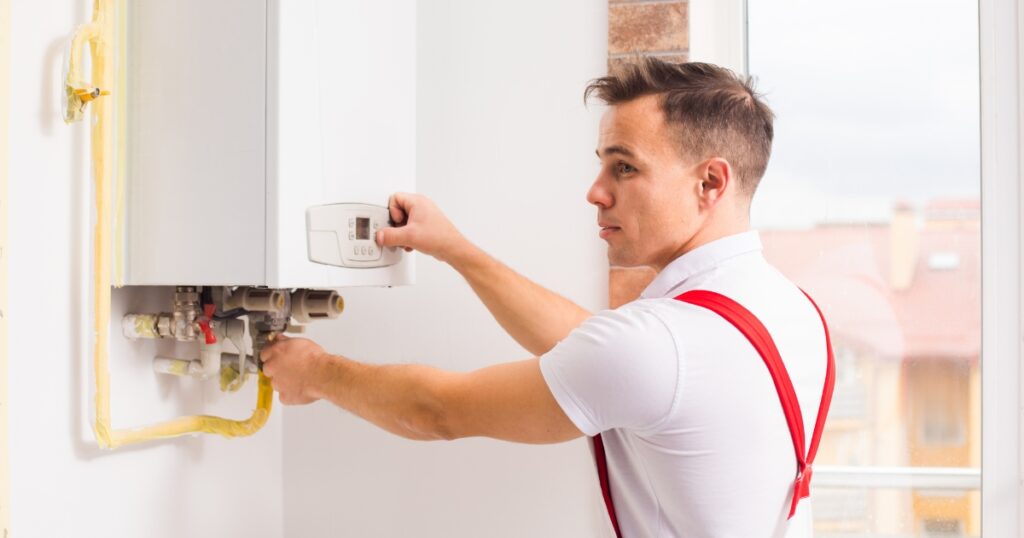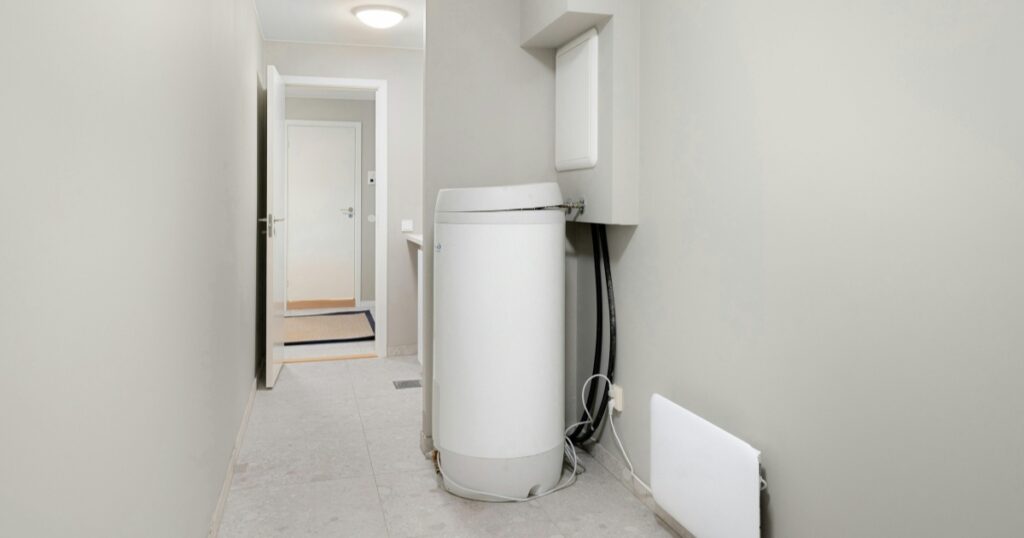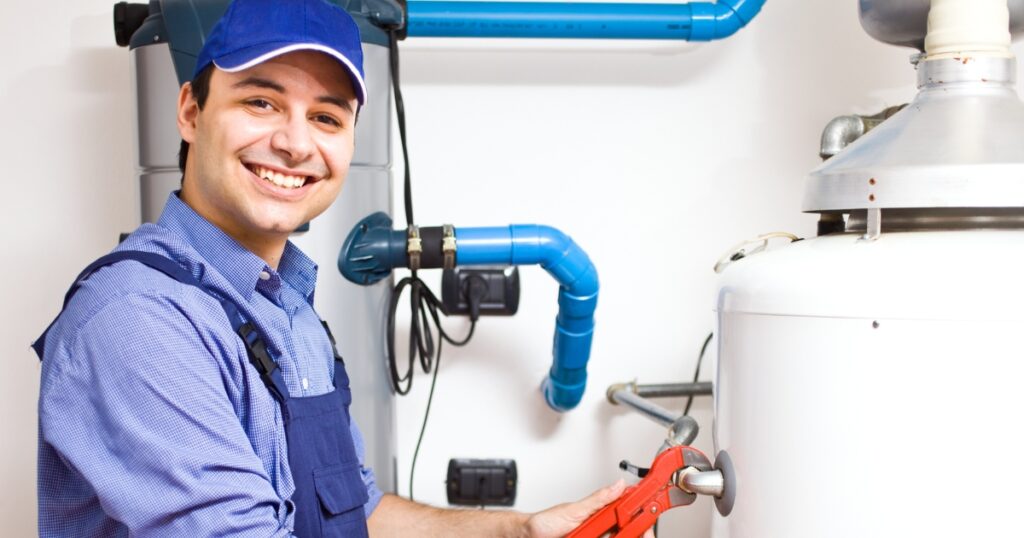Fair dinkum, it’s a real drama when you’re not copping enough hot water, isn’t it? More often than not, a dodgy thermostat is the usual suspect. Using our expertise and proper good research, we’ve sorted out an easy guide on how to fix your Hot Water Heater Thermostat.
So let’s get that lukewarm trickle upgraded to a piping hot shower you truly deserve!
Key Takeaways
- Signs of a faulty hot water heater thermostat include insufficient hot water, water temperature fluctuations, and water that is either too hot or not hot enough.
- DIY steps for hot water heater thermostat repair include turning off power at the circuit breaker, locating and testing the thermostats for power supply, resetting or replacing the faulty thermostat, and restoring power and testing the water temperature.
- It is important to seek professional hot water heater thermostat repair if there are safety hazards or leaks in your system, if you need assistance with complex thermostat replacement, or if you lack experience or knowledge in repairing thermostats.
- Benefits of hot water heater thermostat repair include restored hot water supply, improved energy efficiency and cost savings, and extended lifespan of the water heater.
Signs of a Faulty Hot Water Heater Thermostat
Some signs of a faulty hot water heater thermostat include insufficient hot water, water temperature fluctuations, and water that is either too hot or not hot enough.
Insufficient hot water
We’ve probably all experienced it – turning on the shower only to be greeted with a weak stream of lukewarm water. This annoying issue is often down to a faulty hot water heater thermostat.

The thermostat’s job is to control the temperature of your water, so when it malfunctions, you might find yourself dealing with insufficient hot water in your home. It could also lead to fluctuating temperatures or even scalding hot water.
Diagnosing and repairing this problem requires careful inspection and testing of both upper and lower thermostats in your electric heater system. Don’t worry though; we’ll guide you through this process step by step!
Water temperature fluctuations
Water temperature fluctuations in your hot water system can be frustrating and inconvenient. If you notice that the water in your shower or tap is constantly changing from hot to cold or vice versa, it could be a sign of a faulty thermostat.
The thermostat is responsible for regulating the temperature of the water in your heater, so when it malfunctions, it can result in these fluctuations. Testing all thermostats and checking them for power supply can help determine if any of them need to be reset or replaced.
By addressing this issue promptly, you can ensure a steady supply of consistent hot water throughout your home.
Water that is too hot or not hot enough
If you notice that the water from your hot water system is either too hot or not hot enough, it could be a sign of a faulty thermostat. The thermostat is responsible for regulating the temperature of the water in your water heater.
To diagnose and fix this issue, start by checking the thermostats for power supply and testing them using a multimeter or other methods. If one of the thermostats fails to work properly, it may need to be replaced.
By repairing or replacing a faulty thermostat, you can ensure that your hot water system provides you with consistent and comfortable water temperatures.

DIY Steps for Hot Water Heater Thermostat Repair
To start repairing your hot water heater thermostat, turn off the power at the circuit breaker and locate the thermostats for testing.
Turn off the power at the circuit breaker
To begin repairing your hot water heater thermostat, the first step is to turn off the power at the circuit breaker. This ensures that you can safely work on the thermostat without any risk of electrical shock.
Make sure to locate the correct circuit breaker for your water heater and switch it off completely. By doing this, you’ll be ready to move on to the next steps in diagnosing and fixing your faulty thermostat.
Remember, safety should always come first when working with any electrical appliance.
Locate and test the thermostats for power supply
To diagnose a faulty hot water heater thermostat, the first step is to locate and test the thermostats for power supply. Begin by turning off the power at the circuit breaker to ensure safety.
Then, remove the cover panel of your water heater to access the thermostats. Using a multimeter or other methods, check each thermostat for power supply. If a thermostat doesn’t have any power coming to it, that could indicate a problem with either the wiring or the overall electrical connection of your hot water system.
So remember to be thorough when conducting this inspection and take note of any abnormalities you find during the testing process.
Reset or replace the faulty thermostat
To fix a faulty thermostat in your hot water heater, you have two options: reset or replace it. First, turn off the power at the circuit breaker for safety. Then, locate the thermostats and test them for power supply using a multimeter or other methods.
If one of the thermostats is not functioning properly, you can try resetting it by pressing the reset button. However, if resetting doesn’t solve the problem, it’s likely that you’ll need to replace the faulty thermostat altogether.
Testing all thermostats will help determine which one needs replacement. Remember to restore power after completing these steps and test the water temperature to ensure that your hot water heater is working properly again.
Restore power and test the water temperature
Once you have reset or replaced the faulty thermostat in your hot water heater, it’s time to restore power and test the water temperature. First, make sure that you have turned on the circuit breaker for the water heater at the electrical panel.
Then, give it some time for the heating elements to warm up and start producing hot water again. Once enough time has passed, turn on a faucet and check if the water is coming out at the desired temperature.
If it’s too hot or not hot enough, you may need to make further adjustments to the thermostat settings.
When to Seek Professional Hot Water Heater Thermostat Repair
If you encounter safety hazards or leaks in your hot water system, it is important to seek professional thermostat repair.
Safety hazards and leaks
We understand that safety is a top priority for every homeowner. When it comes to hot water heater thermostat repair, it’s important to be aware of potential safety hazards and leaks.

Faulty thermostats can cause overheating, which may lead to scalding hot water and increase the risk of burns or injuries. Leaks in the water heater can result in water damage and even electrical hazards if the leaking water comes into contact with electrical components.
It’s crucial to address these issues promptly to ensure the safety of your home and family. Remember, if you’re unsure or uncomfortable with tackling these repairs yourself, it’s always best to seek professional assistance from a licensed technician who has experience handling such situations.
Complex thermostat replacement
Replacing a complex thermostat in your hot water system may require professional assistance. This is especially true if you are unsure about the wiring or lack experience with electrical work.
Complex thermostat replacement involves dealing with intricate wiring systems and ensuring proper installation for safe and effective operation. By seeking professional help, you can ensure that the replacement is done correctly, minimising the risk of further damage or safety hazards.
Lack of experience or knowledge
To repair a hot water heater thermostat, it’s important to have some basic knowledge and experience. Without it, attempting DIY repairs can be challenging and may even cause more damage.
It’s crucial to understand the electrical components involved and how to safely work with them. Additionally, troubleshooting a faulty thermostat requires understanding its functions and how to diagnose the issue accurately.
If you lack experience or knowledge in this area, it’s best to seek professional help for hot water heater thermostat repair. They have the expertise needed to fix complex issues and ensure your system is working safely and efficiently without any further complications.
Benefits of Hot Water Heater Thermostat Repair
Restoring your hot water supply, improving energy efficiency and saving costs, and extending the lifespan of your water heater are all benefits you can enjoy from repairing your hot water heater thermostat.
Restored hot water supply
Once the faulty thermostat in your hot water heater is repaired or replaced, you can expect to have a restored hot water supply. No more chilly showers or struggling with lukewarm water! With a properly functioning thermostat, you’ll be able to enjoy consistent and comfortable hot water temperatures whenever you need it.
This means no more sudden drops or fluctuations in temperature while you’re in the middle of a shower or trying to wash dishes. Having a reliable hot water supply will make your daily tasks easier and more enjoyable, ensuring that you have access to the hot water you need for various purposes around your home.
Energy efficiency and cost savings
Repairing a faulty hot water heater thermostat not only restores your hot water supply but also brings significant energy efficiency and cost savings. When the thermostat is functioning properly, it ensures that the water reaches and maintains the desired temperature efficiently, reducing energy consumption.
This means lower utility bills for you in the long run. By fixing or replacing a faulty thermostat, you can enjoy consistent hot water while saving money on your energy expenses. It’s a win-win situation for both your comfort and your wallet.
Extended lifespan of the water heater
Repairing your hot water heater thermostat can contribute to the extended lifespan of your water heater. By addressing any issues with the thermostat promptly, you can prevent further damage and ensure that your water heater operates efficiently for a longer period of time.
Regular maintenance and timely repairs will help keep your water heater running smoothly, providing you with consistent hot water when you need it.
Your Go-To for Immediate Hot Water Repairs
In conclusion, repairing a faulty hot water heater thermostat can be a straightforward DIY project that homeowners can easily tackle. By following the simple steps outlined in this article, you can restore your hot water supply, improve energy efficiency, and extend the lifespan of your water heater.
Remember to prioritise safety and seek professional help if needed. Take control of your hot water system by troubleshooting and repairing the thermostat for optimal performance.
Ensure your hot water stays reliably warm with thermostat repair from Hot Water Repairs Today. Don’t let inconsistent temperatures disrupt your comfort – take action now. Contact us for expert thermostat repair services, ensuring your hot water heater operates efficiently. Trust Hot Water Repairs Today to be your partner in maintaining a consistently comfortable hot water supply. Don’t wait for temperature fluctuations to become a hassle – reach out now and address thermostat issues with confidence. Act today for a hot water system that meets your comfort needs. Contact us now!






